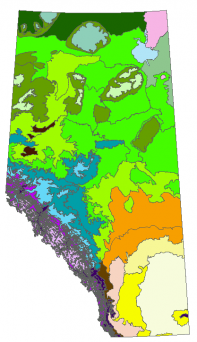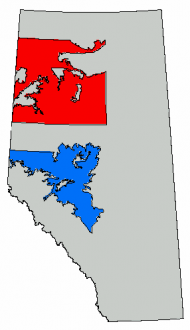5. Seed zones and controlled parentage program regions

How do we accomplish the goal of ensuring adaptation of planting stock, and thereby optimum forest productivity and health? We have seen in the previous section that provenance testing can guide us in understanding to which environmental gradients tree populations are adapted, and how narrow their niche of optimum productivity is. However, even for commercially important forest trees we cannot afford to thoroughly test all provenances at all locations. We can, however, derive some general principles from provenance testing. One general result is local optimality: provenances that originate near the test site often perform best. A second general result is the importance of climate as a selective force that has shaped adaptive traits in trees over the last few thousands of years. We often find differentiation in adaptive traits that are related to drought resistance, timing of the beginning and end of the growing season, frost hardiness, or growing season temperature.
By delineating climatic or ecological regions and using only planting stock that originate within these regions, we can usually be sure that no loss of productivity or forest health occurs due to mal-adaptation. In Alberta, we have a framework of 90 seed zones shown on the image to the right. An alternative that is less sophisticated but is used in some other jurisdictions are seed transfer guidelines. Before we adopted the seed zone system in Alberta, movement of seed was restricted by a transfer guideline that specified a maximum of 80 km distance and 500m elevation movement from source location to a planting site to avoid mal-adaptation.
By delineating climatic or ecological regions and using only planting stock that originate within these regions, we can usually be sure that no loss of productivity or forest health occurs due to mal-adaptation. In Alberta, we have a framework of 90 seed zones shown on the image to the right. An alternative that is less sophisticated but is used in some other jurisdictions are seed transfer guidelines. Before we adopted the seed zone system in Alberta, movement of seed was restricted by a transfer guideline that specified a maximum of 80 km distance and 500m elevation movement from source location to a planting site to avoid mal-adaptation.

The above seed zone system applies to all collections from natural stands on public lands in Alberta. However, for white spruce, black spruce, lodgepole pine, and tamarack we also have material from controlled parentage programs that underwent extensive testing and selection. Because we know much more about the adaptability of this well tested planting material, there is an alternative delineation of controlled parentage program regions, for deployment of planting stock that comes from tree improvement programs. Controlled parentage program regions tend to be larger than seed zones because the genotypes were tested over a wide range of environments and selected to be productive as well as widely adapted to various test site conditions. An example of for proposed aspen regions is shown on the left. You can find maps of controlled parentage program regions for other species on subsequent pages.